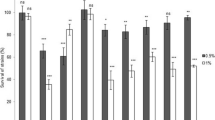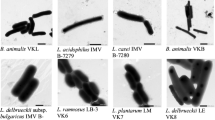Abstract
Purpose of work
To apply a fluorescent dye as an alternative technique to evaluate the survival of potentially probiotic lactobacilli to bile acids (BA) as first step in the design of probiotic functional foods.
The use of lactic acid bacteria (LAB) in the functional food design depends on their ability to survive in the gastrointestinal tract where bile is an important natural barrier. Bile is mainly constituted by conjugated BA, which can be hydrolyzed to free BA and taurine or glycine. Changes in the transmembrane electrical potential (ΔΨ) of probiotic LAB strains due to the effect of conjugated and free BA were measured and showed that the majority of the tested LAB strains had greater sensibility to free BA than to their respective conjugated acids. Variations in the ΔΨ of the microorganism correlated well with bacterial viability determined by standard plate count method. We therefore propose the DiSC3-based fluorescent technique as a rapid and effective method to evaluate the resistance of probiotic lactobacilli to bile as first step for strain selection to be included in functional foods.
Similar content being viewed by others
References
Barer MR, Harwood CR (1999) Bacterial viability and culturability. Adv Microb Physiol 41:93–137
Begley M, Gahan CG, Hill C (2002) Bile stress response in Listeria monocytogenes LO28: adaptation, cross-protection, and identification of genetic loci involved in bile resistance. Appl Environ Microbiol 68:6005–6012
Begley M, Hill C, Gahan CGM (2006) Bile salt hydrolase activity in probiotics. Appl Environ Microbiol 72:1729–1738
Ben Amor K, Breeuwer P, Verbaarschot P, Rombouts FM, Akkermans ADL, De Vos WM, Abee T (2002) Multiparametric flow cytometry and cell sorting for the assessment of viable, injured, and dead Bifidobacterium cells during bile salt stress. Appl Environ Microbiol 68:5209–5216
Breewer P, Abee T (2004) Assessment of the membrane potential, intracellular pH and respiration of bacteria employing fluorescence techniques. In: Kowalchuk GA, de Bruijn FJ, Head IM et al (eds) Molecular microbial ecology manual, 2nd edn. Kluwer, Dordrecht, pp 1563–1580
De Smet I, Van Hoorde L, Vande Woestyne M, Christiaens H, Verstraete W (1995) Significance of bile salt hydrolytic activities of lactobacilli. J Appl Bacteriol 79:292–301
Fernandez Murga ML, Font de Valdez G, Disalvo A, Seldes A (2001) Effect of lipid composition on the stability of cellular membrane during freeze-thawing of Lactobacillus acidophilus grown at different temperatures. Arch Biochem Biophys 388:179–184
Guohong W, Sheng Y, Haoran A, Shangwu C, Yanling H (2010) Coexpression of bile salt hydrolase gene and catalase gene remarkably improves oxidative stress and bile salt resistance in Lactobacillus casei. J Ind Microbiol Biotechnol. doi:10.1007/s10295-010-0871-x
Jones BV, Begley M, Hill C, Gahan CG, Marchesi JR (2008) Functional and comparative metagenomic analysis of bile salt hydrolase activity in the human gut microbiome. Proc Natl Acad Sci 105:13580–13585
Joux F, Lebaron P (2000) Use of fluorescent probes to assess physiological functions of bacteria at single-cell level. Microbes Infect 2:1523–1535
Kell DB, Kaprelyants AS, Weichart DH, Harwood CR, Barer MR (1998) Viability and activity in readily culturable bacteria: a review and discussion of practical issues. Antonie van Leeuwenhoek 73:169–187
Kurdi P, Kawanishi K, Mizutani K, Yokota A (2006) Mechanism of growth inhibition by free bile acids in Lactobacilli and Bifidobacteria. J Bacteriol 188:1979–1986
Mary P, Chihib NE, Charafeddine O, Defives C, Hornez JP (2002) Starvation survival and viable but nonculturable states in Aeromonas hydrophila. Microb Ecol 43:250–258
Mishra V, Prasad DN (2005) Application of in vitro methods for selection of Lactobacillus casei strains as potential probiotics. Int J Food Microbiol 103:109–115
Noriega L, Gueimonde M, Sánchez B, Margolles A, de los Reyes-Gavilán CG (2004) Effect of the adaptation to high bile salts concentrations on glycosidic activity, survival at low pH and cross-resistance to bile salts in Bifidobacterium. Int J Food Microbiol 94:79–86
Succi M, Tremonte P, Reale A, Sorrentino E, Grazia L, Pacifico S, Coppola R (2005) Bile salt and acid tolerance of Lactobacillus rhamnosus strains isolated from Parmigiano Reggiano cheese. FEMS Microbiol Lett 244:129–137
Šušković J, Kos B, Matošić S, Besendorfer V (2000) The effect of bile salts on survival and morphology of a potential probiotic strain Lactobacillus acidophilus M92. World J Microbiol Biotechnol 16:673–678
Taranto MP, Medici M, Perdigón G, Ruíz Holgado AP, Font de Valdez G (2000) Effect of Lactobacillus reuteri on the prevention of hypercholesterolemia in mice. J Dairy Sci 83:401–403
Taranto MP, Vera JL, Font de Valdez G, Hugenholtz J, Sesma F (2003) Lactobacillus reuteri CRL1098 produces cobalamin. J Bacteriol 185:5647–5653
Acknowledgments
This work was supported by grants from CONICET (Consejo Nacional de Investigaciones Científicas y Técnicas), ANPCyT (Agencia Nacional de Promoción Científica y Tecnológica), and CIUNT (Universidad Nacional de Tucumán) from Argentina.
Author information
Authors and Affiliations
Corresponding author
Rights and permissions
About this article
Cite this article
Bustos, A.Y., Raya, R., Bru, E. et al. Application of fluorescent techniques to evaluate the survival of probiotic lactobacilli to bile acid. Biotechnol Lett 33, 1389–1394 (2011). https://doi.org/10.1007/s10529-011-0564-1
Received:
Accepted:
Published:
Issue Date:
DOI: https://doi.org/10.1007/s10529-011-0564-1




